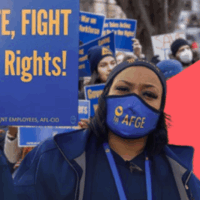A Key Factor Driving Lower Wages and Poor Working Conditions
New York, NY—Voters believe companies’ growing reliance on contracting out for labor is a serious problem that has harmed workers and the economy, according to extensive public opinion research released today by the National Employment Law Project.
The first-of-its-kind national survey, conducted by Hart Research Associates on behalf of NELP, asked 1,000 registered voters about their opinions on the increased use of contract workers and independent contractors (at the expense of direct, permanent employment) throughout the economy.
By five to one, voters say the increase in contracting out—where a company hires an outside firm to supply workers or uses another firm to do work instead of hiring employees directly—over the past 10 years is a bad change. Fifty-nine percent of voters say the increase in subcontracting is a bad change, including 19 percent who say it’s a very bad change, while only 12 percent say it’s a good change. Levels of concern are consistent among Democrats, Republicans, and independents.
“Contracting out isn’t inherently bad. Indeed, a large share of employers contract with independent businesses for various reasons, including securing discreet services that may be more effectively and efficiently provided by a specialty company that performs similar work for other customers,” said Christine Owens, executive director of the National Employment Law Project. “But when companies choose low-road contracting to cut their costs at workers’ expense or to absolve themselves of legal obligations to the people whose labor underlies their success, that’s not okay.”
Owens continued: “Unfortunately, these abuses occur all too often, as more companies opt not to hire or retain direct employees but instead use intermediaries—like staffing agencies or contract firms—to supply the labor they need, or illegally treat their employees as ‘independent contractors,’ stripping them of rights and benefits associated with employee status. In these circumstances, contracting out and independent contractor misclassification can result in substandard, unsafe, poor-quality jobs and violations of workers’ rights.”
Some industries, like construction, have long been built around a subcontracting model. But the practice has spread and grown in numerous lower-wage, high-labor-intensity sectors such as janitorial, home care, delivery and logistics, warehousing, agriculture, and retail, and even in manufacturing, historically a bulwark of middle-class jobs. Workers in these jobs often don’t know who’s the boss—the company that signs their paycheck or the one that sets the contract terms—and their ambiguous legal status is a factor driving lower wages and poor working conditions in our economy today.
Voters recognize valid reasons for subcontracting, such as filling a short-term need, but they believe that companies often contract out in order to save money by avoiding providing benefits and lowering wages. Three in four voters (73 percent) say that using subcontractors in place of direct employees to save money by not providing benefits is a bad reason to use subcontractors. Similarly, 72 percent of voters say that saving money by lowering wages is a bad reason to use staffing agency and contract workers.
Direct employers of subcontracted workers are supposed to provide basic rights and protections to their workers, but many low-road subcontractors meet only minimal standards, shortchange their workers or declare bankruptcy in order to avoid their obligations. Meanwhile, employees misclassified as independent contractors can lose out altogether on fundamental protections under wage and hour, discrimination, and health and safety laws, along with employer-provided benefits and coverage under programs like unemployment insurance and workers’ compensation. .
Subcontracted workers’ wages suffer as compared to their non-contracted peers, ranging from a seven percent dip in janitorial wages, to 30 percent in port trucking, to 40 percent in agriculture; food service workers’ wages fell by $6 an hour after being subcontracted. The same sectors see routine incidences of wage theft, with one in four workers in these jobs reporting minimum wage violations and more than 7 in 10 denied overtime pay.
Researchers have documented a significant rise in companies’ use of subcontracted labor and other forms of alternative work arrangements over the past decade. The percentage of workers employed through temporary help agencies, or as on-call workers, contract workers, and independent contractors or freelancers, rose from 10.1 percent in February 2005 to 15.8 percent in late 2015. The share of workers hired out through contract companies showed the sharpest rise, growing more than five-fold, from 0.6 percent in 2005 to 3.1 percent in 2015. Much of that growth has taken place in sectors once viewed as good-paying jobs, e.g., airport workers, truck drivers, and hospital workers.
Significant majorities of voters support policies to hold companies accountable for misclassifying workers as independent contractors (78 percent support) and for their subcontractors’ failing to pay wages or payroll taxes (71 percent support).
“The lack of accountability arises when there’s more than one company involved in the work and none takes responsibility,” said Owens. “A company’s decision to outsource, use temp or staffing firms, and otherwise insert a labor intermediary between itself and workers who are helping the company succeed should be made carefully. Workers should not be left holding the bag when labor violations or other problems arise in situations involving contracting out or independent contractor misclassification. Companies make the rules governing these arrangements, and it’s they that should be held accountable for ensuring that workers, regardless of how they are classified or how the relationships are structured, receive the protections and benefits they deserve.”
Learn more about the “Contracted Out” national voter survey:
###



